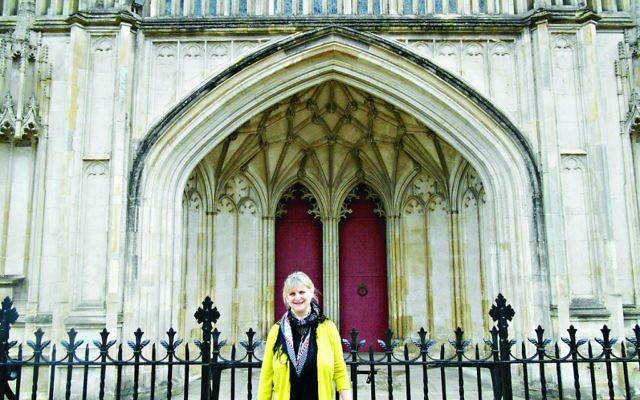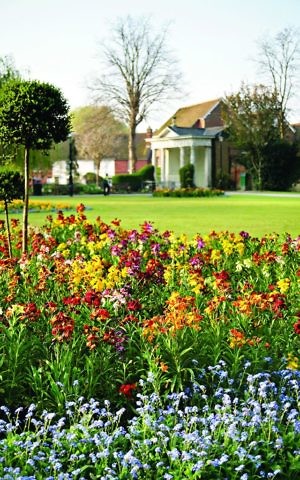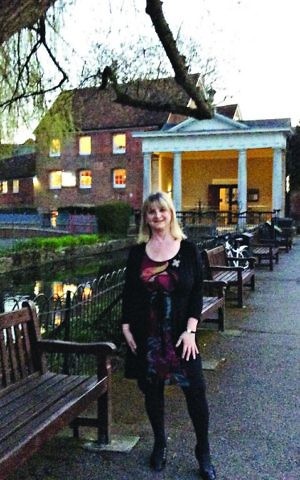Blazing a trail: Visiting Winchester – Britain’s best place to live
We visit Winchester, recently voted Britain’s best place to live, and discover more about the historic city’s Jewish roots
No wonder Winchester has just been voted Britain’s best place to live. I certainly had a feeling of euphoria when I opened my hotel bedroom curtains and saw one of the most magnificent medieval cathedrals just a few feet away.
My mood continued when I spied a yellow wagtail hovering over the picturesque River Itchen, followed by a guided visit to one of the most historic schools in the country, Winchester College.
Despite having such an historic past, the Hampshire city of Winchester has not neglected its present-day temptations.
The population of under 50,000 has a variety of shops to choose from, including department stores such as Debenhams and Primark and many independents.
There is a twice monthly farmer’s market, one of the largest in the UK, and a huge number of festivals, ranging from comedy, film and writing.
The most famous is the July Hat Fair founded in 1974, which takes its name from the tradition of the audience showing their appreciation by putting money in the hat at the end of the show.
The city is also a bit of a food haven and many well-known chefs have restaurants here, from Raymond Blanc to Rick Stein.
The choice is huge, but I plumped for the attractive building by the river that was once a silk mill; it has now been reincarnated into Hugh Fearnley-Whittingstall’s excellent River Cottage Canteen.
Foodie fans are not necessarily locals, as the city has great transport links; it is only an hour’s train journey from London’s Waterloo.
Winchester dates from 150 BC and was first capital of Wessex and then of England. King Alfred lived here and, understandably, his statue dominates the entrance to the main street.
The old round table that hangs in the Great Hall of Winchester Castle was once thought to be associated with the legend of King Arthur and his knights, although now we know it was probably created much later, in about 1290.
Our excellent guide, Michael, showed us around what he explained is the longest medieval cathedral in Europe.
It was consecrated in 1093 and holds so many treasures it is difficult to know where to start – the vibrant 12th and 13th century wall paintings, in which at least one Jewish figure can be identified by his funnel-shaped hat, or perhaps the mortuary chest that contains the bones of King Canute. In the crypt, the oldest part of the cathedral – under water during my visit – is Sound II, a poignant sculpture by Antony Gormley.
Writer Jane Austen lived in Winchester at the end of her life, coming to seek medical assistance from the local hospital, and fans can see her grave on the cathedral floor, with its loving words – but no mention of any novels, as it was unbecoming for a lady to earn a living at the time.
Above the choir, I suddenly spotted a distinct Magen David, but it is thought that it is there purely because it was a symbol at that time. In the same way, a closer look at the tomb of Bishop William of Eddington (1366) shows a swastika pattern on his collar.
We know that, originally, on the outside of the cathedral there were the two medieval statues; Ecclesia representing Christianity – a smiling woman adorned with a crown – and Synagoga, indicating Judaism, wearing unkempt clothes, and with her face turned away, signifying that she cannot see the truth of Christianity.
One of the most important of Winchester’s thoroughfares is Jewry Street.
Yet, strangely the city has never concentrated on the influence of its small but important Jewish population; that is, until now.
Winchester University and the City Council have organised a new Medieval Jewish Trail, which traces the setbacks and successes of the community that lived here, which was only ever as large as 200 people and ranged from the very poor to the extremely rich.
Our guide, Steve Heath, explained: “The Jewish population came from Rouen, in France, after being invited in 1070 by William the Conqueror to take on the roles of money lenders and traders.
“The ambitious king was short of cash, and needed help to stimulate economic development and his own personal projects.
“Quite soon, Winchester became one of the wealthiest Jewish settlements in England.”
The walk takes about an hour-and-a-half and requires considerable imagination, as only hints of the history can still be seen.
Winchester Castle was founded in 1067, and within it, Jews’ Tower was an area where it was possible to escape any pogroms, such as the one in 1265, when Simon de Montfort killed all those who did not seek refuge there.
Again in 1287, the entire Jewish population was imprisoned to ensure they paid the large tax imposed by King Edward I on the whole country’s Jewish residents.
This drip of persecution was in evidence until 1290, when Jews were expelled from England altogether.
My favourite character from Steve’s tour has to be plucky Licoricia, perhaps the most notable English Jewish woman of her time. She was born near the beginning of the 13th century and married twice.
After the death of her first husband, Abraham, Licoricia continued living in Winchester with her daughter Belia, and three sons, Isaac, Benedict (Baruch) and Lumbard, and first started lending money in 1230.
Just 10 years later, she was the richest moneylender in the city. Her second marriage, to the wealthy David of Oxford, produced Asher, a much needed heir for him.
The continuation of her successful business activities even after being widowed a second time, is a spellbinding story.
She was briefly imprisoned in the Tower of London, and was frequently received at the court of King Henry III. Licoricia was known to be courageous, beautiful and still kept her strictly kosher diet!
Eventually she was killed alongside her maid in a treacherous robbery and buried in the city’s Jewish cemetery.
Her son, Baruch continued to be an important person in the community, paying a tax so that the Jews in Winchester were exempt from wearing the strip of yellow felt that identified them.
Eventually he, too, was killed, on a trumped-up charge of coin clipping (illegally shaving metal from gold and silver coins).
Asher, Licoricia’s youngest son, became a financier and did very well, until he was driven from England in the expulsion of 1290.
Lucy’s useful contacts:
The next Medieval Jewish Trail takes place on 16 July: private walks can be arranged too. Details: email MJW@winchester.co.uk or visit www.winchester.ac.uk/MJW
Mercure Winchester Wessex Hotel: www.mercure.com
River Cottage Canteen, Winchester: www.rivercottage.net/canteens/winchester

Thank you for helping to make Jewish News the leading source of news and opinion for the UK Jewish community. Today we're asking for your invaluable help to continue putting our community first in everything we do.
For as little as £5 a month you can help sustain the vital work we do in celebrating and standing up for Jewish life in Britain.
Jewish News holds our community together and keeps us connected. Like a synagogue, it’s where people turn to feel part of something bigger. It also proudly shows the rest of Britain the vibrancy and rich culture of modern Jewish life.
You can make a quick and easy one-off or monthly contribution of £5, £10, £20 or any other sum you’re comfortable with.
100% of your donation will help us continue celebrating our community, in all its dynamic diversity...
Engaging
Being a community platform means so much more than producing a newspaper and website. One of our proudest roles is media partnering with our invaluable charities to amplify the outstanding work they do to help us all.
Celebrating
There’s no shortage of oys in the world but Jewish News takes every opportunity to celebrate the joys too, through projects like Night of Heroes, 40 Under 40 and other compelling countdowns that make the community kvell with pride.
Pioneering
In the first collaboration between media outlets from different faiths, Jewish News worked with British Muslim TV and Church Times to produce a list of young activists leading the way on interfaith understanding.
Campaigning
Royal Mail issued a stamp honouring Holocaust hero Sir Nicholas Winton after a Jewish News campaign attracted more than 100,000 backers. Jewish Newsalso produces special editions of the paper highlighting pressing issues including mental health and Holocaust remembrance.
Easy access
In an age when news is readily accessible, Jewish News provides high-quality content free online and offline, removing any financial barriers to connecting people.
Voice of our community to wider society
The Jewish News team regularly appears on TV, radio and on the pages of the national press to comment on stories about the Jewish community. Easy access to the paper on the streets of London also means Jewish News provides an invaluable window into the community for the country at large.
We hope you agree all this is worth preserving.
























